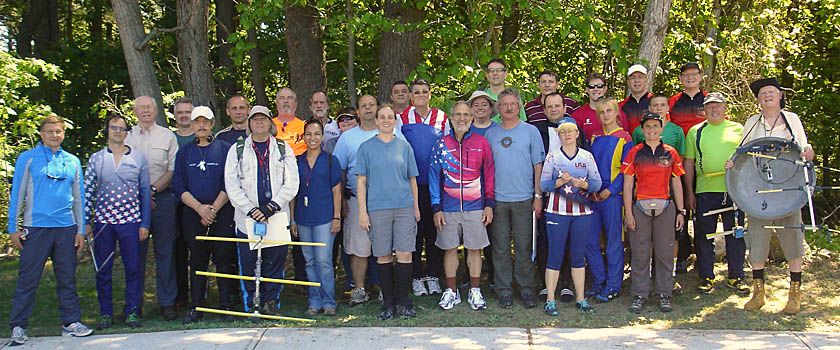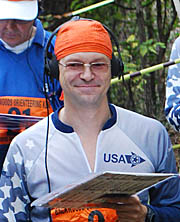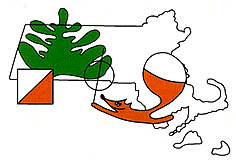
Group photo of the competitors just before the two-meter competition on Saturday, June 7, taken by Marvin Johnston KE6HTS.


 In the 1620s, when Puritan colonists arrived in the area that is now Boston, they called it "Trimountaine," which means "Three Mountains." By 1890, those mountains were mostly gone. Nineteenth-century engineers excavated the tops of mountains and hills, including the crown of Beacon Hill, so they could fill in the mud flats and mill ponds, tripling the land area of the city.
In the 1620s, when Puritan colonists arrived in the area that is now Boston, they called it "Trimountaine," which means "Three Mountains." By 1890, those mountains were mostly gone. Nineteenth-century engineers excavated the tops of mountains and hills, including the crown of Beacon Hill, so they could fill in the mud flats and mill ponds, tripling the land area of the city.
Greater Boston is now USA's tenth-largest urban area in terms of population and fortunately there are plenty of hills left. There are also numerous parks and open spaces that are perfect for Amateur Radio Direction Finding (ARDF) contests under international rules. This radiosport, which is also called foxtailing and radio-orienteering, has gained so much popularity that Beantown was chosen as the site of the USA ARDF Championships for the second time.
In 2014, as in each even-numbered year, the World ARDF Championships took place in mid-September. In these years, USA must select its team members before the end of June so that there is plenty of time for World Championship registration and trip planning. This means that the best time for the USA Championships is in early June, which is ideal for Boston. On average, the daily high temperature is 76 degrees then with 11 days of measurable rain.
Organizing these championships and setting all the courses was Vadim Afonkin KB1RLI. As a youth, Vadim learned ARDF and won awards for it in his native Russia. After coming to America, he first participated in USA's national championships in 2003 and has competed in almost every USA championships since then. At the 2012 World Championships in Serbia, he captured a gold, a silver and a bronze medal for the USA in competition against radio-orienteers from 33 nations. Assisting Vadim were members of the Cambridge Sports Union and the New England Orienteering Club (NEOC), the source of the excellent course maps.
Most Foxes in Shortest Time
USA's national championships are open, meaning that visitors from other countries are welcome. Visitors compete for individual medals in an overall division that includes everyone, but of course they cannot earn positions on the USA team. This year, visiting competitors came from Canada, Germany, Russia and Ukraine.
Activities opened on Thursday, June 5 with the sprint event at Arnold Arboretum, a 265-acre parcel owned by Harvard University and used for horticultural research and education. One goal of the sprint is to demonstrate ARDF to the public with a fast-paced radio race. This was a fine location for that purpose, even though there was rain during most of the day.
Sprint competitors attempt to find ten 80-meter CW transmitters that are divided into two groups, with each group on a separate frequency. The transmitters in a group are separated by at least 100 meters and are on for twelve seconds each in a one-minute cycle. Starting at two-minute intervals, competitors find their required foxes from the first group in any order, pass the spectators through a marked corridor to punch a fixed control transmitter, then find the required foxes in the second group before going to the finish line.
Fewer than half of this year's competitors arrived in time for the sprint. For some, it was their first experience in direction-finding on 80 meters. All of them found at least five transmitters, with course times ranging from twenty-two minutes to just over an hour.
Four more competitors arrived by Friday morning, when everyone headed to Lynn Woods Reservation for the foxoring competition. At 2200 acres, this is the second largest municipal park in the greater Boston area. It is a combination of wildlife preserve and aquifer for drinking water, with a wide variety of flora and wildlife within.

Foxoring is another 80-meter event, but its emphasis is on orienteering as much as it is on direction-finding. Competitors received a map with the start marked on the east side, the finish on the south side, and ten small circles scattered over the remainder of the area. Starting at two-minute intervals, they used their orienteering skills to reach the circles required by their age/gender categories. Inside or nearby each circle was a QRP continuously-operating transmitter with a range of about 100 meters for them to find.
This large area with its hills plus many lakes and ponds made for a very difficult course. Four participants found some transmitters but took more than the two and a half hour time limit. Leszek Lechowicz, NI1L was the only one to find all ten transmitters. At one hour and 45 minutes, he also had the fastest course time of the day.
The rest of this year's competitors arrived late Friday for the classic two-meter event on Saturday morning. It took place in Saugus at Breakheart Reservation, whose 640 acres include hardwood forests, rocky hills, two freshwater lakes and a section of the Saugus River.
Vadim set a very difficult two-meter course. Only one person was over the two-and-a-half-hour time limit, but almost half of the competitors needed more than two hours to finish. Afterward, they took the afternoon to rest and recuperate, then everyone went to Kings in Dedham for the traditional feast and awards ceremony.
Back to Blue Hills
The last event was the classic 80-meter run on Sunday morning. The site was Blue Hills Reservation, where championship competitions had taken place in 2009. These 7000 acres are the largest open space within a major metropolitan area. There is skiing every winter followed by hiking, fishing, camping and swimming in the warm months. Most of these woods are runable, if you don't mind trails that go up and down 300-foot hills.
Participants parked their vehicles near the finish area at Houghton's Pond and walked about two kilometers to the starting point in the southeast corner of the mapped area. Then they set out at five-minute intervals to find four CW transmitters (the fifth malfunctioned) that were well scattered throughout the site.
Signal reflections from the hills often cause bad bearings on two meters, but not on eighty. With only four transmitters to find, it would be normal to have some competitor times under an hour. However, Blue Hills is very difficult terrain. The best time of the day was 1:07:05 by NI1L.
Nobody was overtime and electronic scoring provided running results for viewing by everyone on a computer monitor at the finish. This made it possible to give out the 80-meter awards in plenty of time for those with late afternoon homebound flights to get to Logan Airport.
In the final tally, USA's top finishers in each age/gender category were Leszek Lechowicz NI1L (M40 2m, 80m, sprint, foxor), Nicolai Mejevoi (M50 2m, 80m, sprint, foxor), Bill Noyce AB1AV (M60 sprint), Bob Cooley KF6VSE (M70 2m, 80m, sprint), Alla Mezhevaya (W35 2m, sprint), Addison Bosley KJ4VCV (M21 2m, 80m, foxor, Joseph Huberman K5JGH (M60 2m, 80m, foxor), Jen Harker W5JEN (W35 80m, foxor) and Marji Garrett KJ4ZKC (W50 80m).
Four pages of photos of the championships are now in this Homing In Web site. Also in this site are complete results and transmitter location maps.
Portions of this report have been excerpted from my Homing In column in the December 2014 issue of CQ-Plus digital magazine.
Joe Moell KØOV
USA ARDF Coordinator
Text and photos copyright © 2014 Joseph D. Moell. All rights reserved.
 Go to First photo page of this event
Go to First photo page of this event
Go to Championships Foxhunting News -- Recent and upcoming ARDF championships events
Go to International-Style Foxhunting Comes To The Americas -- How we're getting the ball rolling
Go to Equipment Ideas for Radio-Orienteering -- Simple and inexpensive receiving and transmitting solutions
Go to Radio-Orienteering News for Southern California -- Results and stories of recent radio-orienteering events in southern California, plus announcements of upcoming ones.
Go to Foxhunting for Scouts -- Let's get the kids involved
 Back to the Homing In home page
Back to the Homing In home page
This page updated 21 April 2015